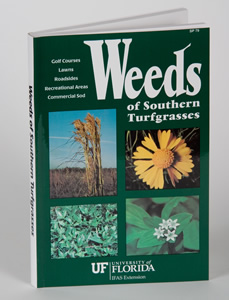
by Taylor Vandiver | Aug 3, 2015
As our world and our lives become more centered on technology it seems that all the information we need is just a touch screen away. After all, you are most likely reading this article from a laptop, smart phone, or tablet. While convenient and portable, there are some places you might not wish to take your electronics and one of those places is in the garden. You may say, “Well Taylor, that’s what they make waterproof, shatterproof, dirt proof, etc. cases for!” and I would say that you’re right. However, technology has many limiting factors such as battery life and screen glare. Now believe me, I am by no means disparaging technology! I come from a generation that considers Wi-Fi as necessary as water and an outlet comparable to oxygen. But there is something to be said for having a book in hand when out in the garden. For one thing your neighbors won’t worry about you as they see you march around the garden with your phone in the air doing the “No Signal Dance”. Also, a book is great to have in order for you to jot down any notes or reflections. I would like to list for you a few books that I often reference when I receive calls from homeowners. These books will cover various topics and all of them can be found on the UF/IFAS Bookstore website, the links for each can be found below. If you have any questions contact your local Extension Office and, as always, feel free to contact me and I can give you a rundown on my collection of favorite reference books!
- New to the UF/IFAS bookstore: “Trees: North & Central Florida” a field guide to 140 common tree species. This sturdy, pocket-sized field guide–the only one of its kind for north and central Florida–is designed for landscape professionals, arborists, naturalists, gardeners, and anyone seeking to know the trees around them. Full color photographs of leaves, bark, flowers and full trees, together with clear descriptions and other information make identifying trees easier than ever. This book also features a handy diagnostic key, an introduction to plant parts, a glossary and a ruler to guide you, whether you’re a trained botanist or a complete beginner.
- “Poisonous Plants of the Southern United States” John W. Everest, Thomas A. Powe, Jr., and John D. Freeman (of Auburn University). Identification of common poisonous plants found along fence lines and in pastures in the Southern United States.
- “Weeds of Southern Turfgrasses” This practical weed identification guide contains 427 color photographs of 193 weed species, their geographical range, and life cycle descriptions. Includes a glossary of taxonomic terms and index of common and scientific names.

- “Disorders and Diseases of Ornamental Palms” Recently revised and updated, this ID deck is a diagnostic tool for landscape professionals and backyard hobbyists. The color photographs and explanatory text helps users identify and distinguish between the nutritional deficiencies, physiological disorders and common diseases of ornamental palms. All palms in the U.S. suffer from disorders and diseases, and identifying the differences can be tricky. These cards feature photographs and descriptions and are cross-referenced for easy comparison between different symptoms and the potential problems causing them. Includes a table of contents and 55 laminated, ring-bound cards.
- “Florida Lawn Handbook: Best Management Practices for Your Home Lawn in Florida” Written in practical language by turfgrass experts, this highly-anticipated new edition offers the most current lawn management information. Color plates identify various grass types, weeds, diseases, and insects—including those that are good for your lawn! Chapters cover selection, establishment, and maintenance for each type of lawn; soil analysis and fertilization; yearly calendars for lawn care and culture; mowing, watering, and calibrating sprinkler systems and fertilizer spreaders; overseeding for winter color; preparing a lawn for drought and low temperatures; safe pesticide application and use; the latest integrated pest management strategies; organic lawn care; and complete, illustrated diagnostic information for weeds, diseases, insect problems, nematodes, and other pests.
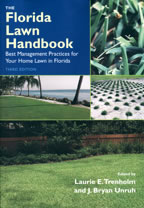
- “Sustainable Gardening for Florida” Gardeners today face a unique challenge: how do you create a beautiful, thriving landscape without over-use of fertilizers, pesticides, and water? Sustainable Gardening for Florida might be the first place to look for answers. This book provides interesting, money-saving ideas to reduce your ecological footprint. It includes chapters on composting and mulching, integrated pest management, water-wise irrigation and rainwater harvesting, preparing your garden for disasters, and all aspects of managing meadows, lawns, trees and shrubs, edible gardens, rain gardens and waterfront gardening.
- “Vegetable Gardening in Florida” From James Stephens, the founder of the Florida Master Gardener Program, this is the one resource you need to successfully grow vegetables in Florida. Whether you’re growing beans, tomatoes, herbs, or any other Florida crop, this guide will take you from site selection and insect management through the harvest and storage of your produce. Useful planting guides, gardening measurement conversions, and organic gardening information are accented with full-color throughout.

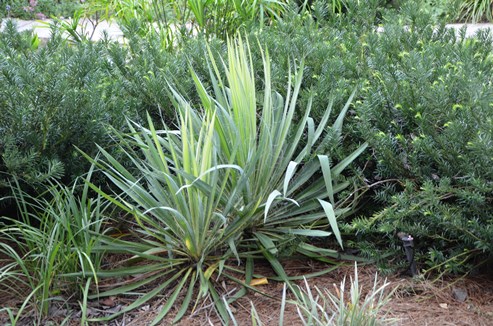
by Les Harrison | Jul 15, 2015

Native yuccas fit easily into the landscape without breaking the bank or the back of the gardener.
Being sharp is usually considered a complement. It implies the recipient of this assessment has the intellectual ability and the mental acuity to handle with ease the rigors of contemporary life.
In north Florida’s native plant world the yucca genus was sharp long before people employed it in landscapes. It also has the sharp pointy spines to enforce its tactics.
Local yuccas are perennial shrubs which can grow into small trees with a unique shape. There are approximately 50 species in this genus worldwide on every continent except Antarctica.
Their most obvious and notable feature which makes them easy to identify is their leaves. These are elongated in thick clusters around the stems.
The sword-like shape is tipped with a hardened point which can quickly get the attention of anyone passing too close. The bristly structure of these evergreen plants gives them an intimidating appearance which most animals and people avoid.
The annual blooms appear at the top of these plants and protrude above the greenery. Honeybees and other pollinators will visit the profusely fragrant bell-shaped flowers to collect nectar and pollen.
In their native range, these plants are seen in sites where there is high exposure to the sun. They will not grow in heavy shade, and languish with little change if there is less than six to eight hours of daily sun.
Sandy well drained soils are the most likely locations where yuccas will prosper and grow. Their nutrient requirement are low, so they rarely display symptoms of a nutrient deficiency.
Likewise, their need for water is paltry. Once established they will easily withstand droughts and extended dry periods.
The common species native to north Florida in this genus are Adam’s needles (Yucca filamentosa) and Spanish bayonets (Yucca aloifolia). These plants are similar in appearance, but each has distinctive traits.
Adam’s needles are the smaller and shorter of the two species. The multiple stems may reach three feet in height, but extend to over six feet when the cream color blooms appear in early summer.
The green leaves are pliable with white threads of fiber trailing from each. There is a variegated cultivar which is popular for landscaping projects.
Spanish bayonets produce multiple trunks per plant and may grow to over 15 feet. They produce rigid dark green leaves projecting from the thick trunks and will impale any trespasser.
White blossoms appear in the center of the plant above the foliage from spring to late summer depending on several weather related factors. These yuccas have a high salt tolerance making wild plantings common to coastal areas.
Disease and insect problems are few for these hardy plants. Too much water resulting in excessively wet roots and extreme cold are the biggest problems.
For the sharp homeowner these native plants make a pointedly good addition to the landscape.
To learn more about native yuccas in north Florida, contact the nearest UF/IFAS Extension office.

by Matthew Orwat | Jul 15, 2015

Coneflower, after deadheading, with new growth and flowers. Photo Credit Matthew Orwat, UF/IFAS Extension
During these “dog days”, full of hot temperatures punctuated with intermittent rain, gardeners can lose the motivation to get out there and get things done. One task, deadheading, can make a huge difference in the appearance of one’s landscape without a whole lot of effort.
The act of deadheading is the removal of individual blooms or flowering stalks that are past their prime. When deadheading, always trim the stem to an area above a node. The node can be determined by the presence of a leaf and its attachment to a stem. This area is known as the leaf axle.
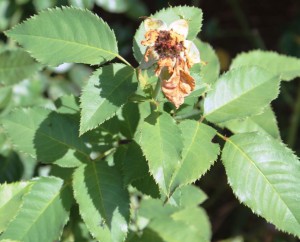
Roses before and after deadheading Photo Credit Matthew Orwat, UF/IFAS Extension
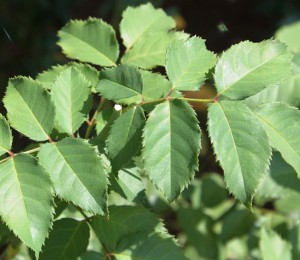
Roses before and after deadheading Photo Credit Matthew Orwat, UF/IFAS Extension
The main benefit of deadheading flowering shrubs and perennials, particularly in the spring and summer, is that removal of spent flowers promotes new growth and more flowers. It also eliminates unsightly seed stalks and decaying petals from the landscape. If trying to save seed or promote re-seeding, do not deadhead in the fall or near the terminal side of a given season for any plant.
Once proper deadheading is performed, new growth will emerge from the trimmed area. Oftentimes, this new growth is another single flower or flower cluster.
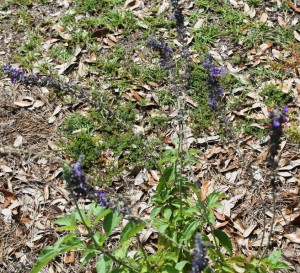
Salvia, before and after deadheading Photo Credit Matthew Orwat, UF/IFAS Extension
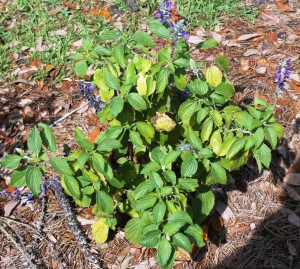
While this process is generally used for repeat flowering shrubs, such as roses, it can also be used effectively on crapemyrtle, salvia, cone flower, coreopsis, and many others.
Promote an extended bloom season in the garden and deadhead!
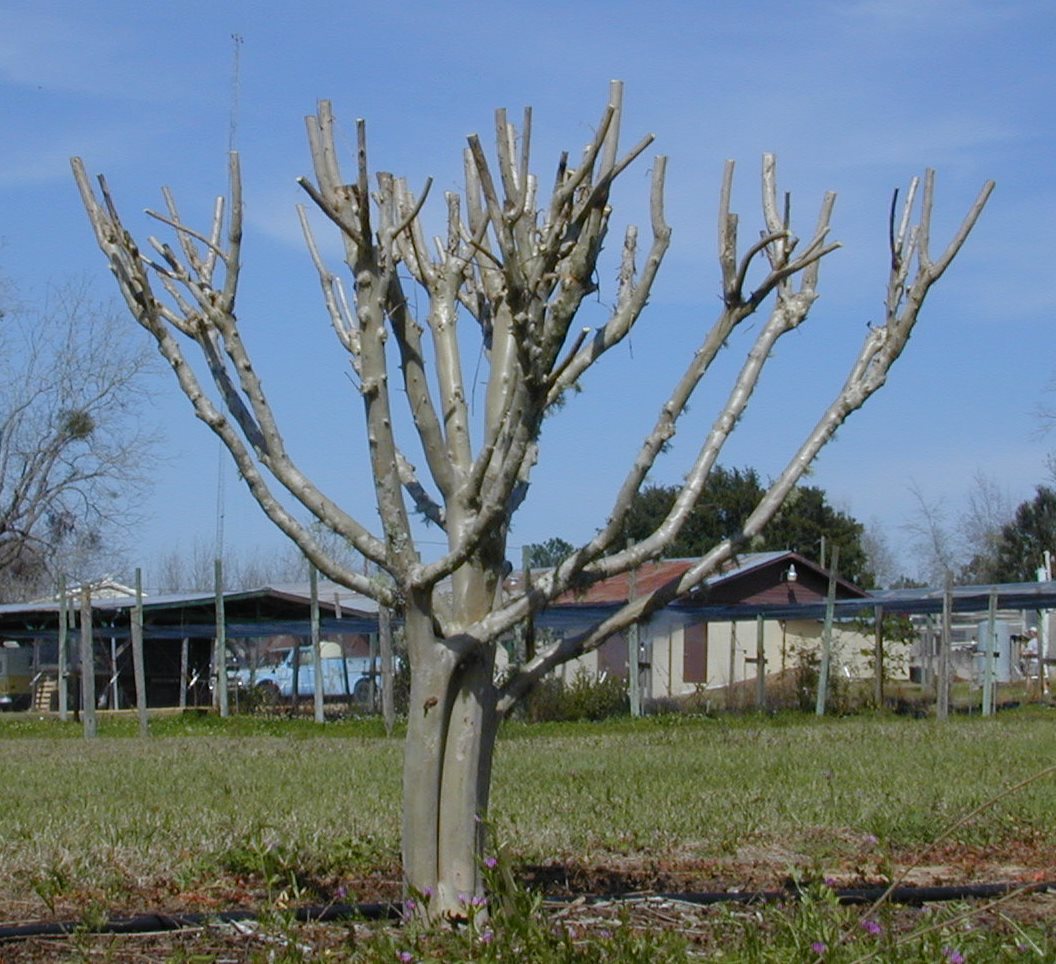
by Gary Knox | Jun 23, 2015
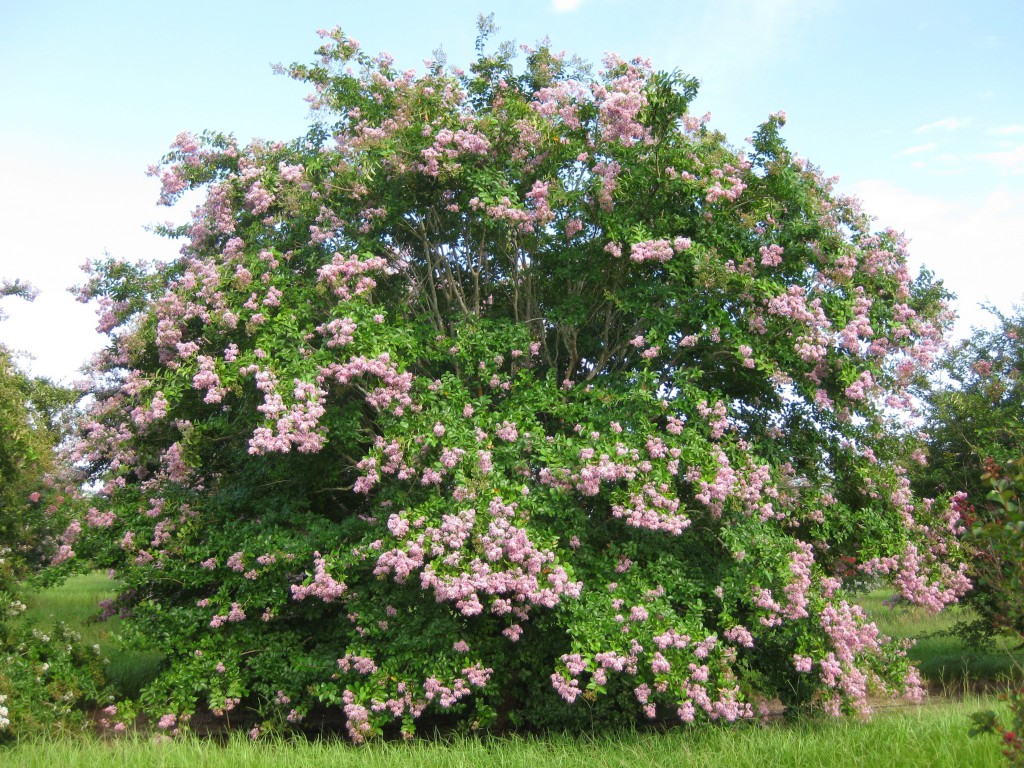
Figure 3. With proper cultivar selection and placement in the landscape, crapemyrtle develops into a beautifully shaped tree that rarely needs pruning. This crapemyrtle is ‘Muskogee’. Image Credit Gary Knox
Crapemyrtle flowering is set to be spectacular this year! While most other garden plants droop from summer’s heat, humidity and heavy rains, crapemyrtle thrives and puts on an outstanding show of flowers all summer and fall. Thanks to modern breeders, we have all sizes of improved hybrid crapemyrtles with flower colors of lavender, purple, white, pink, or red.
Just say “No” to Pruning
Crapemyrtle varieties come in tree-size, patio tree and shrub categories. Tree-size crapemyrtles grow 25 ft. tall and are ideal as flowering trees. Patio tree-form plants (up to 12 ft.) are beautiful as small, flowering specimen plants near patios, walkways, and entrances. Shrub forms (up to 6 ft.) make excellent accents in a shrub border and smaller types are effective as large groundcovers or container plants. Make sure you buy the right size crapemyrtle for your home. Don’t make the mistake of planting a tree-size crapemyrtle in an area too small for its ultimate size, or you’ll find yourself pruning it hard – and often – to keep it from out-growing its place.
Recommended Varieties
Some of the best tree-size (25 ft.) types are Natchez (white), Red Rocket® (red), Sioux (pink) and Apalachee (lavender). Superior patio tree crapemyrtles (12 ft.) are Acoma (white), Cheyenne (true red), Tonto (fuchsia red), Hopi (pink) and Catawba (purple). Smaller shrub (6 ft.) crapemyrtles are hard to find, but Cherry Dazzle® is a nice mounding red and Pixie White and New Orleans (purple) are good selections.
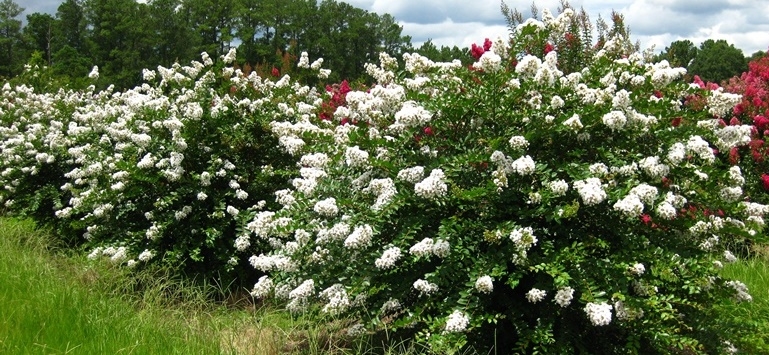
Planting and Garden Care
When it comes to planting, crapemyrtle is very tolerant and forgiving with three exceptions. Firstly, crapemyrtle needs sun to flower freely, so plant it in a site receiving at least six hours of direct sunlight each day. Secondly, crapemyrtle will not grow in wet soils. Finally, never plant crapemyrtle too deep — if you do so, it will punish you by not flowering for years and years. Planting too deep literally smothers the roots, requiring the crapemyrtle to regenerate a new root system in the soil above.
Crapemyrtle is very drought tolerant and almost seems to thrive on neglect. On the other hand, regular watering and fertilizer will help crapemyrtle grow faster and bigger.
More Beauty on the Way!
Breeders are continuing to improve and introduce new crapemyrtles. Many new varieties were released in the last couple years. In particular, watch for new types with purple-burgundy leaf color all summer long! Time will tell which new ones grow best in our area. Stay tuned as the world of crapemyrtle continues to evolve and improve!
*Gary Knox is Professor of Environmental Horticulture with the University of Florida. He is stationed at the North Florida Research and Education Center in Quincy, where he evaluates more than 100 cultivars of crapemyrtle.

by Matthew Orwat | May 19, 2015
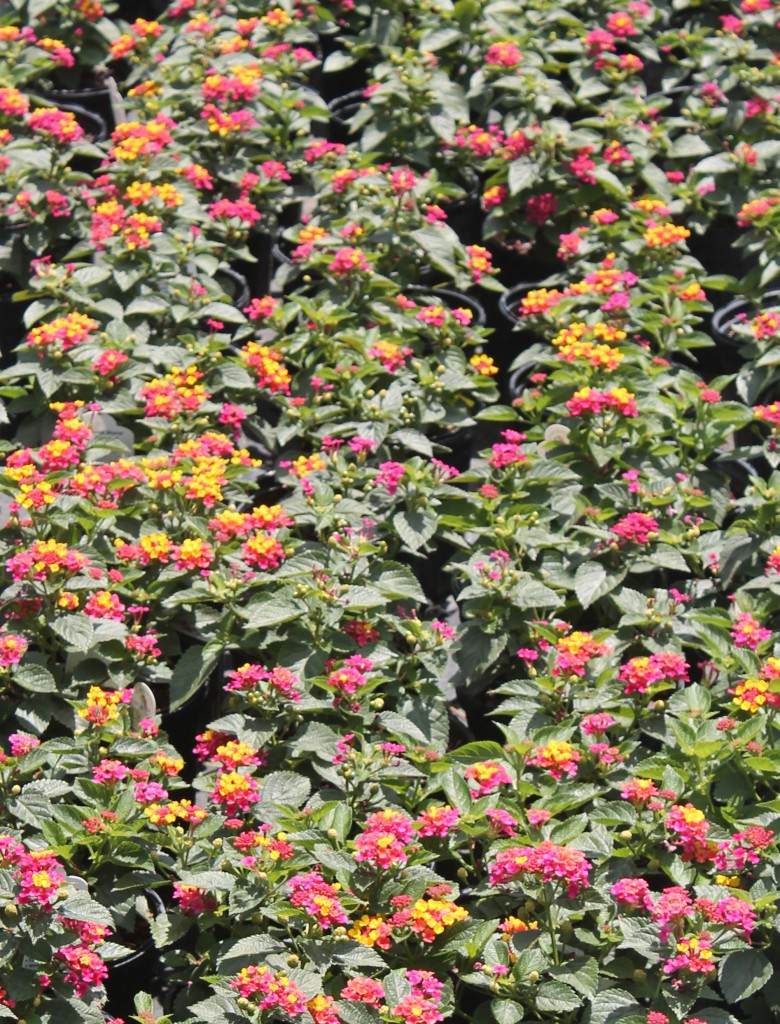
Dwarf lantana – Image UF IFAS Extension, Matthew Orwat
With the heat of summer already here, we all know that our pansies, petunias and snapdragons are on their way out. This leaves us wondering what we could plant that will give us color throughout summer and fall to the first frost.
Many are weary of Lantana camara, the common garden lantana, because of its potential as an invasive species and large rampant size. Good news, there are several dwarf cultivars that have no invasive potential because they are sterile. Additionally, many other dwarf cultivars grow slow and produce few seed, so they have low invasive potential.
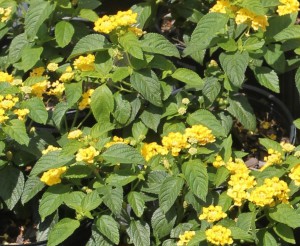
Dwarf lantana. Image credit UF/IFAS, Matthew Orwat
Northwest Florida is not in the natural range of the endangered South Florida native Lantana depressa, so the outcrossing danger does not exist in our area.
Dwarf lantanas are available in either mounding or trailing types. Mounding types rarely get over 1 foot tall and have an equal spread while trailing lantanas stay lower to the ground but can spread several feet. They are available in several colors including yellow, purple, white, multicolor and red. They provide reliable color in flushes from late spring until first frost
When mature, dwarf lantana are drought tolerant but need supplemental watering to get established. They also thrive in poor soils and need little fertilization.
Dwarf lantana usually acts as a perennial, but die to the roots during extremely cold winters.
Lantanas that are known to be relatively non-invasive include Patriot, Hallelujah, Sunburst, and Cowboy. Florida Exotic Pest Plant Council recognizes the cultivars ‘Gold Mound’, ‘New Gold’, ‘Alba’ and ‘Patriot’ as cultivars that are not known to produce viable seeds. Other newer dwarf varieties need to be evaluated on a case by case basis, but varieties the author has observed as no to low seed set in the landscape. Also if home gardeners are worried about seed production, spent blooms can be pinched off so no seed can form. This pinching off practice also speeds up re-bloom and is thus highly encouraged.
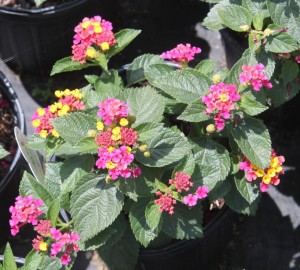
Dwarf lantana – Matthew Orwat, UF/IFAS
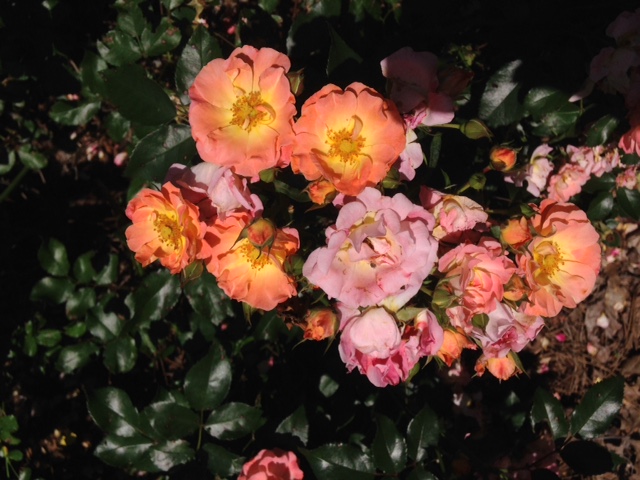
by Julie McConnell | May 6, 2015
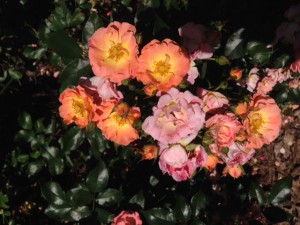
Peach Drift® Rose blooming in Quincy at the UF/IFAS NFREC Photo: J.McConnell, UF/IFAS
Growing roses in the South can have challenges and many gardeners think that they are just too high maintenance to plant. Plant developers are aware of this opinion and have worked to develop low maintenance roses that can make a novice gardener look like a pro.
The trend in horticulture is to develop and release plant series where closely related plants have similar characteristics but offer some diversity such as different flower color and size. A new series that is performing well in North Florida is Drift® Groundcover Roses. Available with flower colors ranging from white, yellow, pink, apricot, to red. All exhibit a low growing habit and will remain under three feet tall and spread up to four feet wide. Flowers are born in dense clusters for most of the year, only taking a break in the winter months.
Although not completely disease free, these roses do show resistance to rust, powdery mildew, and black spot which are common problems with roses. Deadheading is not necessary, but can be done to increase bloom and keep plants looking tidy. One of the best characteristics of the Drift® Groundcover Rose series is that they don’t get very tall, so they fit in small spaces. If you are looking for incredible color in a sunny site with limited space give this series a try.
Although low maintenance, roses do still require some attention, for more information read Growing Roses in Florida.


















